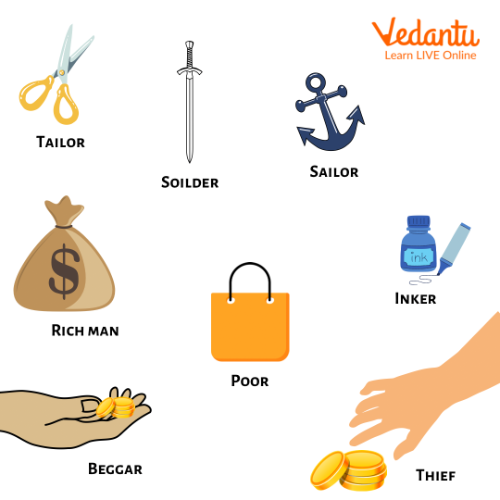What is “Tinker, Tailor”?
Tinker Tailor is a classic English counting game, nursery rhyme, and fortune-telling song that may be used to tally up cherry stones, buttons, daisy petals, and other objects. Both youngsters in Britain and America frequently use it for "counting out," such as selecting who will be "It" in a game of tag. To decide who will be "it" in a game of tag, it is common practice in the USA to sing this song. It is a children's counting song based on the rhyme.
Origin of Tinker, Tailor Nursery Song
William Caxton's The Game and Player of the Cheese (about 1475), in which the pawns are given the names "Labourer, Smith, Clerk, Merchant, Physician, Taverner, Guard, and Ribald," has a similar rhyme.
The earliest instance of the first four occupations being combined is found in William Congreve's Love for Love (1695), which has the following passage:
A Soldier and a Sailor, a Tinker and a Tailor
Had once doubtful strife, sir.
The rhyme, which starts with the words "My belief - a captain, a colonel, a cowboy, a thief," was first compiled in the 1840s by James Orchard Halliwell to count buttons. The words "Rich guy, Poor man, beggar-man, Thief, Doctor, Lawyer (or Merchant), Indian chief" were printed by William Wells Newell in Games and Songs of American Children in 1883, and it's possible that American tradition is where the contemporary lyrics originated.

Tinker, Tailor Nursery Song
“Tinker, Tailor” Lyrics
An English modern version:
Tinker, Tailor,
Soldier, Sailor,
Rich Man, Poor Man,
Beggar Man, Thief.
An American modern version:
Rich Man, Poor Man,
Beggar Man, Thief,
Doctor, Lawyer, (or “Merchant”)
Indian Chief.

Tinker Tailor Soldier Sailor
Tinker Tailor Meaning
The rhyme "Tinker, Tailor" is a component of a larger counting or divination game that young girls frequently play to predict their destinies. The girl will pose a question and then call out a sequence of events or things by repeating the rhyme throughout the divination. Up to the final object or action in the series, the rhyme is repeated. The final phrase or word repeated will be the one that comes true. One can count the number of buttons on clothing, petals on a flower, bounce of a ball, hop over a rope, etc.
Do It Yourself
What words rhyme with Tailor?
The first version of the nursery rhyme was first published in _____.
1475.
1695.
1890.
None of these
Sample Question
1. Tinker Tailor nursery rhyme was traditionally played in ________.
England.
Britain.
America.
None.
Ans: The counting game, nursery rhyme, and song "Tinker Tailor" are all popular in England. Hence, the correct option is (A) England.
Conclusion
The first phrases of an ancient nursery rhyme. It is sometimes used to predict what a youngster will become as an adult by counting objects, such as seeds from recently eaten fruit. "Tinker, tailor, soldier, sailor, rich man, poor man, beggar man, thief," is the whole version.


FAQs on Tinker, Tailor Nursery Song
1. Where did the phrase "Tinker Tailor Soldier Sailor" come from?
William Congreve's Love for Love (1695) contains the earliest instance of the first four occupations being combined when it states: "A Soldier and a Sailor, a Tinker and a Tailor, Had once an uncertain strife, sir."
2. What is a "tinker" in the sense of the "Tinker Tailor Soldier Sailor" nursery song?
A strategy used by kids to decide between two or more options for items or people. The youngster names each job while pointing to each object in turn (or alternately), stating the rhyme "tinker, tailor, soldier, sailor, wealthy man, poor man, beggar-man, thief" before moving on to the next item.
3. Who is the author of Tinker Tailor Soldier Spy?
Author of "Tinker Tailor Soldier Spy" and former spy John le Carré, who passed away aged 89.





